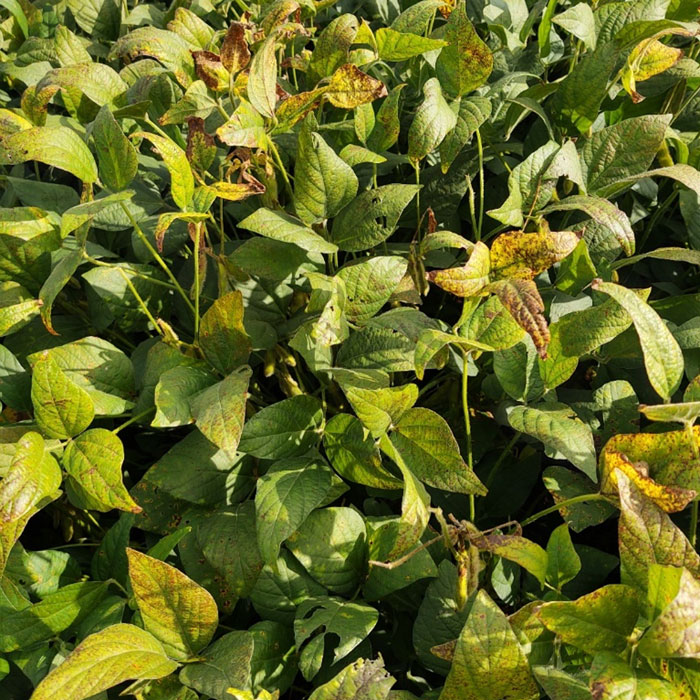Cercospora Leaf Blight (CLB) is a fungal disease caused by the pathogen Cercospora kikuchii. This disease primarily affects soybean crops and is known for causing significant yield losses and diminishing the quality of the harvest. It's crucial for commercial soybean producers to understand the implications of CLB, recognize its symptoms accurately, and adopt effective management strategies to mitigate its impact.
Impact on Soybeans:
- Yield Loss: CLB can lead to considerable yield losses, mainly through reduced photosynthetic area as the disease progresses.
- Quality Degradation: Infected plants may produce seeds with a lower oil content and increased protein levels, affecting the market value.
- Disease Spread: The pathogen can easily spread across fields, especially in conditions favoring disease development such as high humidity and warm temperatures.
Precise Documentation in Fields:
To manage CLB effectively, accurate identification and quantification in the field are crucial:
Symptom Recognition:
- Early Stages: Look for small, dark, reddish-purple spots on the upper leaf surfaces.
- Advanced Stages: As the disease progresses, these spots enlarge, and leaves may turn yellow and exhibit premature defoliation.
Quantification:
- Sampling: Randomly select a number of plants from various locations in the field.
- Assessment: Examine the leaves at different plant stages, noting the presence and severity of the symptoms.
- Counting: Use a standard assessment scale (e.g., 1-5, with 1 being no disease and 5 being severe) to rate disease severity.
Technology Integration:
Incorporating modern technology like the Inspagro app can revolutionize the management of CLB:
Offline Field-Scouting:
- Data Collection: Technicians can collect data directly from the field, even without an active internet connection.
- Symptom Documentation: High-resolution images of affected plants can be captured and annotated for precise symptom documentation.
Collaborative Efforts:
- Data Sharing: Information can be shared instantly among farm members and third-party stakeholders to ensure prompt decision-making.
- Expert Consultation: Easy sharing features allow for quick consultations with pathologists or agronomists.
Efficiency and Cost-Effectiveness:
- Input Optimization: Accurate disease monitoring allows for targeted fungicide application, reducing unnecessary costs.
- Labor Efficiency: Simplifies the scouting process, making it easier for both experienced technicians and the tech-savvy younger generation.
Decision Support:
- Data-Driven Decisions: Historical data and real-time monitoring help in predicting disease outbreaks and making informed management decisions.
In conclusion, effectively managing Cercospora Leaf Blight in soybean crops demands a comprehensive approach that combines accurate field scouting, regular monitoring, and the integration of advanced technological solutions like Inspagro. Such an approach not only helps in mitigating the impact of the disease but also enhances the overall efficiency and cost-effectiveness of farming operations.
FAQs
What is Cercospora Leaf Blight and what causes it? Cercospora Leaf Blight (CLB) is a fungal disease in soybeans caused by the pathogen Cercospora kikuchii. It's known for significantly impacting crop yield and quality.
How does CLB affect soybean crops? CLB primarily leads to yield losses by reducing the photosynthetic area of plants. It also causes quality degradation, with seeds exhibiting lower oil content and higher protein levels.
What are the ideal conditions for CLB spread? CLB thrives and spreads more rapidly in conditions with high humidity and warm temperatures, making vigilant monitoring essential in such environments.
How can I recognize the early and advanced stages of CLB? In its early stages, CLB presents as small, reddish-purple spots on upper leaf surfaces. As it advances, these spots enlarge, and leaves may turn yellow and fall off prematurely.
What role does technology, like the Inspagro app, play in managing CLB? The Inspagro app aids in offline field-scouting, data collection, and symptom documentation. It facilitates collaborative efforts through data sharing and expert consultation, enhancing decision-making and efficiency in managing CLB.
What are the benefits of accurately managing CLB? Accurate management of CLB through field scouting and technology integration leads to optimized fungicide application, labor efficiency, cost-effectiveness, and better overall farming decisions based on real-time data.


.jpg)

Comments
Post a Comment